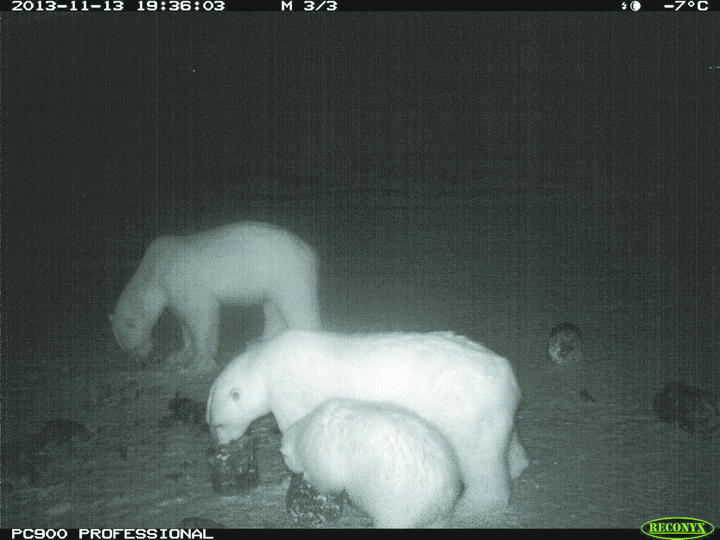Nunavut MLA calls for bigger west Hudson Bay polar bear quotas
Bear populations reaching hazardous levels, says Joe Savikataaq

This night photo shows polar bears outside of Arviat clawing at frozen seal meat. The local wildlife office put the food outside the hamlet limits in November 2013 to keep the bears at bay as they migrate north. (PHOTO COURTESY OF ARVIAT WILDLIFE OFFICE)
Nunavut MLA Joe Savikataaq is calling on the territorial government to increase the total allowable harvest for polar bears along the west coast of Hudson Bay, where he says bear populations have hit dangerously high levels.
“Arviat has learned to live with an abundance of polar bears,” Saviqataaq said in question period March 18. “Every fall, they damage property, they kill dogs, and some folks are scared to go out at night, especially elders.”
“Mr. Speaker, some of these bears have lost their fear of humans and they willfully damage cabins and property,” he said.
The MLA for Arviat South pointed out that the total allowable harvest of bears in the Western Hudson Bay sub-population, which covers the south of the Kivalliq region, is 24 bears.
Of these, eight bears have been allowed for harvest through hunting tags in Arviat for each of the past three years.
But Arviat’s quota, as in neighbouring communities, has been used up in defence of life and property, he said.
“For three years, there was absolutely no hunting by communities that hunt the Western Hudson Bay population,” he said.
Savikataaq said hunting quotas for the neighbouring sub-population area of Southern Hudson Bay are much higher – even though population estimates are roughly 1,000 for each area.
Southern Hudson Bay covers Sanikiluaq and parts of northern Quebec and northern Ontario. The community of Sanikiluaq in southern Hudson Bay has 25 tags, and northern Quebec has 60 tags, Savikataaq said.
“Simple math means this population has 85 tags for polar bears that can be harvested, while our zone only has 25, and that is too much of a discrepancy,” the MLA said.
He then asked Nunavut’s environment minister, Johnny Mike, if his department could double the total allowable harvest for South Hudson Bay to 48.
Mike replied that Savikataaq’s question addressed three separate issues.
Firstly, polar bear harvest quotas would be concluded in the territorial government’s most recent polar bear management plan for the territory, he said, which will be ready by fall of 2014.
The department of environment “will be able to review the survey results from the area near Arviat, during the southern Kivalliq polar bear management planning process,” Mike said.
Harvest levels in Western Hudson Bay are a separate issue, he said, although this is also being reviewed under the planning process. Harvest levels offshore of Sanikiluaq – in Northern Quebec – are not the purview of the territorial government, he said.
The bear hunt quota for the Southern Hudson Bay polar management plan “will be quite complex for both the Nunavut government as well as my department,” Mike said, due to “overlapping jurisdictions for the management of those bears.”
The government must consult with the Nunavik Marine Regional Wildlife Board in Quebec to resolve the Southern Hudson Bay quota, he said.
Nunavut’s position, based on 2012 population estimates, is to have a total allowable harvest of 45 bears for that zone, the minister said.
Speaking of polar bear populations in the Kivalliq region, Mike said “many Inuit are stating that the population has increased, and this seems fairly obvious.”
Recommendations for Nunavut’s new polar bear management plan will be reviewed by the department of environment and the Nunavut Wildlife Management Board, Mike said.





(0) Comments